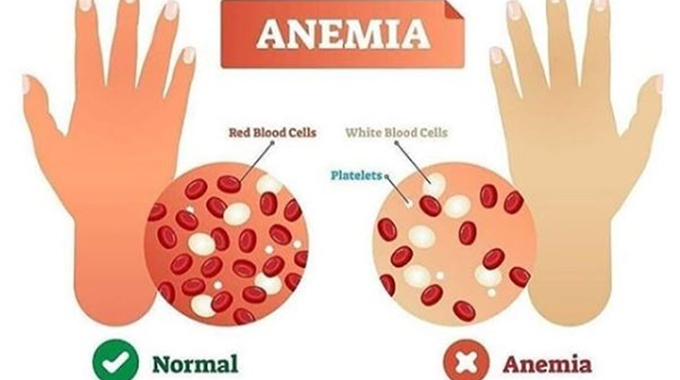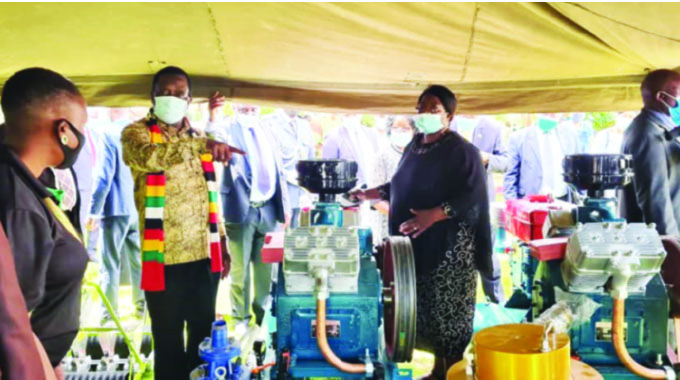Anaemia: When something simple as iron deficiency can cause harm

Rumbidzayi Zinyuke Health Buzz
As a child, Mary (not her real name) was almost always tired and would have trouble sleeping and doing a lot of things other children her age were doing.
Instead of going to play after school, she would just lie down on her bed and go to sleep.
For her parents and other relatives, Mary was what they called in Shona as ‘ndonda’ (a sickly child).
At the age of 10, she was always fatigued, experienced insomnia, dizziness, her hands and feet were cold, her heart would always be racing and she generally looked frail.
What her family did not know was that she was experiencing symptoms of iron deficiency.
She was only told that she was anaemic at the age of 13 after a visit to the doctor who ordered a full blood count on her.
Anaemia is defined as a low number of red blood cells.
The condition is a serious, usually neglected public health problem that particularly affects young children, menstruating adolescent girls and women, and pregnant and post-partum women.
The World Health Organisation estimates that 40 percent of children aged six to 59 months of age, 37 percent of pregnant women, and 30 percent of women aged 15–49 years worldwide are anaemic.
In Zimbabwe, the prevalence of anaemia among women of reproductive age (ages 15-49) was 28,90 percent as of 2019 and 37,80 percent in children under the age of five years.
Among pregnant women, the prevalence of anaemia was 31,70 percent.
Anaemia can cause a range of non-specific symptoms including tiredness, weakness, dizziness or light-headedness, drowsiness, and shortness of breath, especially upon exertion.
Children and pregnant women are especially vulnerable, with more severe cases of anaemia leading to an increased risk of maternal and child mortality.
Iron deficiency anaemia has also been shown to affect cognitive and physical development in children and reduce productivity in adults.
“Anaemia is an indicator of both poor nutrition and poor health. It is problematic on its own, but it can also impact other global public health concerns such as stunting and wasting, low birth weight and childhood overweight and obesity due to lack of energy to exercise. School performance in children and reduced work productivity in adults due to anaemia can have further social and economic impacts for the individual and family,” said the WHO.
In a routine blood test, anaemia is reported as a low haemoglobin or haematocrit. Haemoglobin is the main protein in the red blood cells and carries oxygen, and delivers it throughout the body.
Symptoms of anaemia like fatigue or shortness of breath happen because the organs will not be getting what they need to work the way they should.
Certain forms of anaemia are passed down through genes, and infants may have it from birth.
Women are at risk of iron-deficiency anaemia because of blood loss from their periods and higher blood supply demands during pregnancy.
Older adults have a greater risk of anaemia because they are more likely to have kidney disease or other chronic medical conditions.
The signs that someone has anaemia may be so mild that people may not even notice them.
According to experts, there are more than 400 types of anaemia divided into three groups: anaemia caused by blood loss, anaemia caused by decreased or faulty red blood cell production and anaemia caused by destruction of red blood cells.
In the case of Mary, iron-deficiency anaemia happens because one does not have enough of the mineral iron in their body. The bone marrow needs iron to make haemoglobin, the part of the red blood cell that takes oxygen to the organs.
Iron-deficiency anaemia can be caused by a diet without enough iron, certain drugs, foods, and caffeinated drinks.
Digestive conditions such as Crohn’s disease may also cause the condition to develop while donating blood often, endurance training, pregnancy and breastfeeding may also use up iron in the body.
For women, getting your period is good enough to cause iron deficiency.
Other forms of anaemia include vitamin-deficiency anaemia, dietary deficiencies, sickle cell anaemia, megaloblastic anaemia and pernicious anaemia among many others.
Anaemia may also be associated with other chronic conditions such as advanced kidney disease, hypothyroidism, cancer, lupus, diabetes, rheumatoid arthritis and old age.
If not treated, anaemia can cause many health problems, such as severe tiredness. It can also cause pregnancy complications such as premature birth.
Heart problems can also be complications of anaemia as it can lead to a rapid or irregular heartbeat, called arrhythmia.
With anaemia, the heart must pump more blood to make up for too little oxygen in the blood. This can lead to an enlarged heart or heart failure.
Death may also be imminent in some cases.
Some inherited anaemias, such as sickle cell anaemia, can lead to life-threatening complications.
While many types of anaemia cannot be prevented, there are things one can do to minimise impact of anaemia.
Eating a healthy diet might prevent iron deficiency anaemia and vitamin deficiency anaemias.
This includes iron-rich foods like beef and other meats, beans, lentils, iron-fortified cereals, dark green leafy vegetables, and dried fruit.
Folate is also an important nutrient and can be found in fruits and fruit juices, dark green leafy vegetables, green peas, kidney beans, peanuts, and enriched grain products, such as bread, cereal, pasta and rice.
Foods rich in vitamin B-12 including meat, dairy products, and fortified cereals and soy products as well as Vitamin C-rich foods like citrus fruits and juices, peppers, broccoli, tomatoes, melons, and strawberries may help the body take in iron.
Anaemia is not only an African problem but a global issue that needs to be tackled urgently.
To this end, the WHO recently launched its first-ever comprehensive framework on reducing anaemia, which called on countries to accelerate action to halve anaemia prevalence in women of reproductive age by 2025.
“Progress on reducing anaemia has been slow and the world is not on track to reach the global target. Anaemia is a serious global public health problem, affecting 571 million women and 269 million young children worldwide,” the global health body said.
It was established that the condition was most prevalent in low- and middle-income countries.
“Most work on addressing anaemia has been focused on the prevention and treatment of iron deficiency,” says Francesco Branca, the director of WHO’s department of Nutrition and Food Safety. “However, anaemia is a complex condition with multiple causes – including other nutritional deficiencies, infections, inflammation, gynaecological and obstetric conditions, and inherited red blood cell disorders.”
This means that all causes of anaemia must be addressed to effectively prevent and treat anaemia.
The new framework sets forth ways to address the direct causes, risk factors and broad social inequities that are fundamental drivers for anaemia.
It describes the necessarily comprehensive approach that brings together multiple sectors and actors, and lays out key action areas to improve the coverage and uptake of interventions
Acknowledging that health remains the predominant sector for delivering many of the recommended interventions, the framework also proposes actions that other societal stakeholders can take.
These include governments, civil society organisations, academia, researchers, funding agencies, international organisations and media, all of which plays a particular role to perform in reducing anaemia and keeping people healthy.
Feedback: [email protected]








Comments